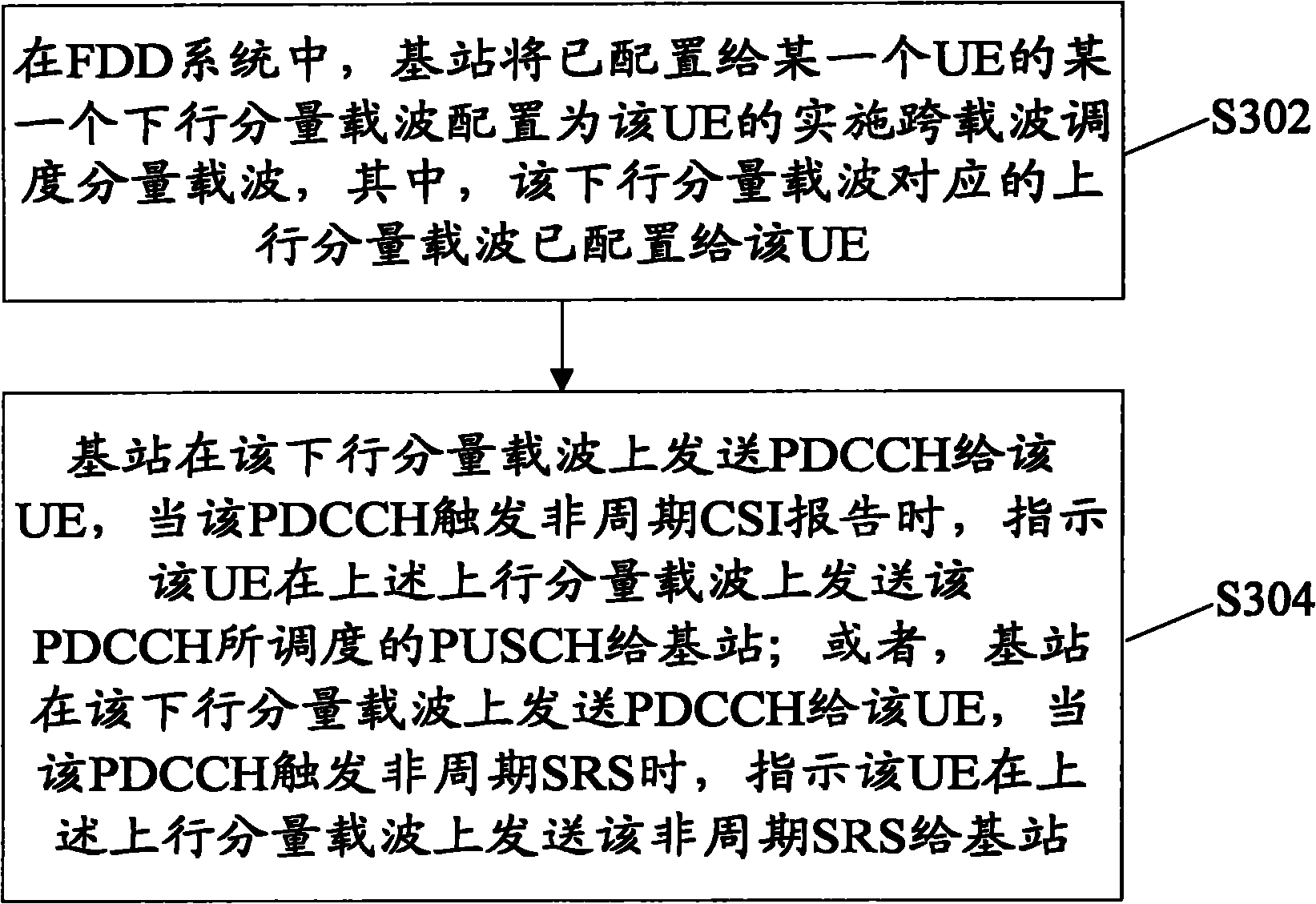Physical downlink control channel sending method and base station for cross-carrier scheduling
A technology of physical downlink control and cross-carrier scheduling, which is applied in transmission path sub-channel allocation, wireless communication, pilot signal allocation, etc., and can solve problems such as the inability to indicate aperiodic SRS transmission and the inability to indicate PUSCH transmission.
- Summary
- Abstract
- Description
- Claims
- Application Information
AI Technical Summary
Problems solved by technology
Method used
Image
Examples
Embodiment 1
[0049] In the LTE-A FDD system, the base station configures a pair of primary component carriers DL CC0 and UL CC0, a pair of secondary component carriers DL CC1 and UL CC1, and two downlink secondary component carriers DL CC2 and DL CC3 for a certain UE. The uplink secondary component carriers UL CC2 and UL CC3 associated with SIB-2 are not configured for the UE).
[0050] Under cross-carrier scheduling, only DL CC0 or DL CC1 can be configured as the UE's PDCCH CC, and DL CC2 or DL CC3 cannot be configured as the UE's PDCCH CC.
[0051] For the UE, configure DL CC0 as the PDCCH CC, and the PDCCH sent on DL CC0 can schedule DL CC0 and UL CC0, DL CC1 and UL CC1, and DL CC2 and DL CC3.
[0052] When the UE detects its PDCCH for scheduling the PUSCH on DL CC0, and CQI request=1, the CIF contained in the PDCCH is used to instruct the UE to feed back the aperiodic CSI report of the specified component carrier. And the PDCCH schedules the UE to send the PUSCH on UL CC0.
[005...
Embodiment 2
[0072] In the LTE-A FDD system, the base station configures a pair of primary component carriers DL CC0 and UL CC0, a pair of secondary component carriers DL CC1 and UL CC1, and two downlink secondary component carriers DL CC2 and DL CC3 for a certain UE. The uplink secondary component carriers UL CC2 and UL CC3 associated with SIB-2 are not configured for the UE).
[0073] (1) For the UE, configure DL CC0 as the PDCCH CC, and the PDCCH sent on DL CC0 can schedule DL CC0 and UL CC0, DL CC1 and UL CC1, and DL CC2 and DL CC3.
[0074] When the UE detects its PDCCH for scheduling the PUSCH on DL CC0, and CQI request=1, the CIF contained in the PDCCH is used to instruct the UE to feed back the aperiodic CSI report of the specified component carrier. The PDCCH schedules the UE to send the PUSCH on the UL CC0 with the smallest component carrier index among the uplink component carriers that can be scheduled by the DL CC0.
[0075] When the UE detects its PDCCH for scheduling PDSCH ...
Embodiment 3
[0083] In the LTE-A TDD system, the base station configures one primary component carrier CC0 and three secondary component carriers CC1, CC2 and CC3 for the UE.
[0084] (1) If CC2 is configured as a PDCCH CC for the UE, and the PDCCH sent on CC2 can schedule CC0 (its CIF value is 2), CC1 (its CIF value is 3), and CC2 (its CIF value is 0), CC3 (which has a CIF value of 1).
[0085] When the UE detects its PDCCH for scheduling the PUSCH on CC2, and CQI request=1, the CIF is used to instruct the UE to feed back the aperiodic CSI report of the specified component carrier. The PDCCH schedules the UE to send the PUSCH on CC1 with the largest CIF value among component carriers that can be scheduled by CC2.
[0086] When the UE detects its PDCCH on CC2 for scheduling the PDSCH, and the PDCCH triggers an aperiodic SRS, the CIF contained in the PDCCH is used to indicate the component carrier where the PDSCH scheduled by the PDCCH is located. The PDCCH schedules the UE to send the ap...
PUM
 Login to View More
Login to View More Abstract
Description
Claims
Application Information
 Login to View More
Login to View More - R&D
- Intellectual Property
- Life Sciences
- Materials
- Tech Scout
- Unparalleled Data Quality
- Higher Quality Content
- 60% Fewer Hallucinations
Browse by: Latest US Patents, China's latest patents, Technical Efficacy Thesaurus, Application Domain, Technology Topic, Popular Technical Reports.
© 2025 PatSnap. All rights reserved.Legal|Privacy policy|Modern Slavery Act Transparency Statement|Sitemap|About US| Contact US: help@patsnap.com



